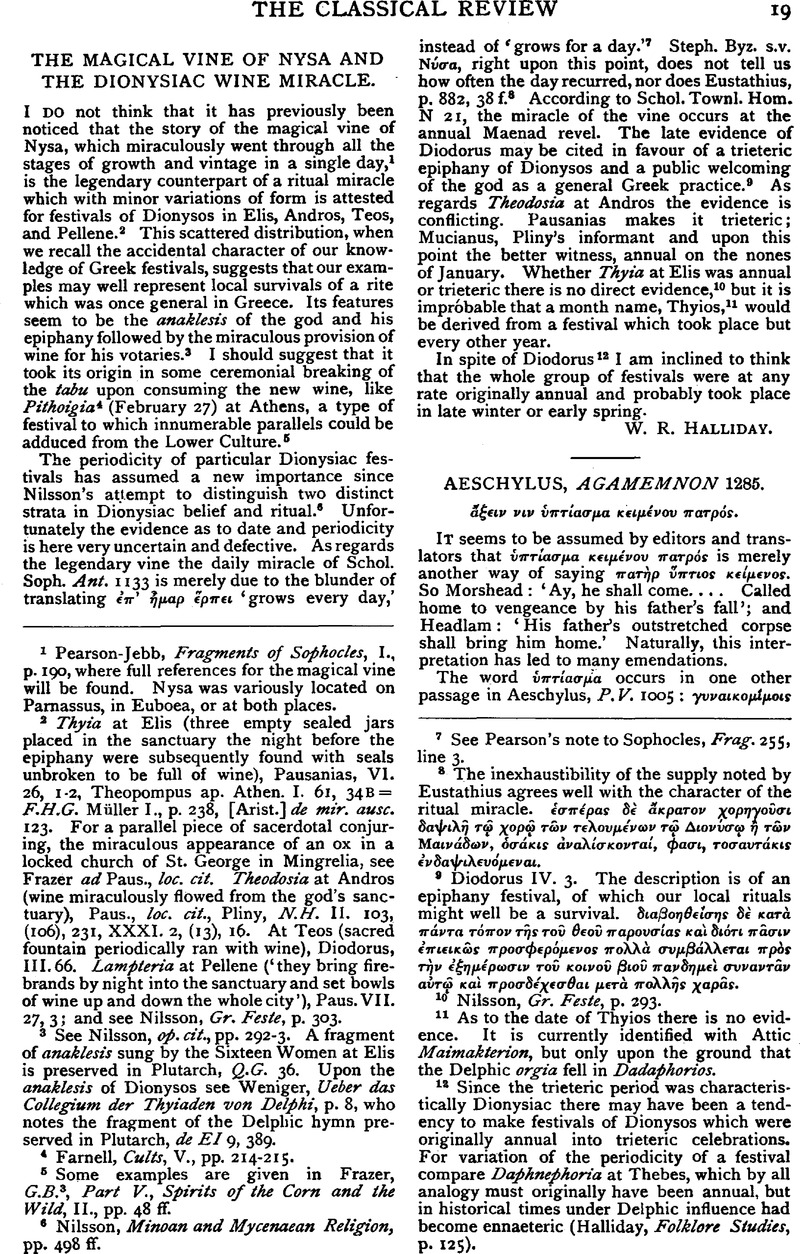Article contents
The Magical Vine of Nysa and the Dionysiac Wine Miracle
Published online by Cambridge University Press: 27 October 2009
Abstract

- Type
- Review Article
- Information
- Copyright
- Copyright © The Classical Association 1928
References
1 Pearson-Jebb, , Fragments of Sophocles, I., p. 190Google Scholar, where full references for the magical vine will be found. Nysa was variously located on Parnassus, in Euboea, or at both places.
2 Thyia at Elis (three empty sealed jars placed in the sanctuary the night before the epiphany were subsequently found with seals unbroken to be full of wine), Pausanias, VI. 26, 1–2, Theopompus ap. Athen. I. 61, 34B = F.H.G. Müller I., p. 238, [Arist.] de mir. ausc. 123. For a parallel piece of sacerdotal conjuring, the miraculous appearance of an ox in a locked church of St. George in Mingrelia, see Frazer ad Paus., loc. cit. Theodosia at Andros (wine miraculously flowed from the god's sanctuary), Paus., loc. cit., Pliny, N.H. II. 103, (106), 231, XXXI. 2, (13), 16. At Teos (sacred fountain periodically ran with wine), Diodorus, III.66. Lampteria at Pellene (‘they bring firebrands by night into the sanctuary and set bowls of wine up and down the whole city’), Paus. VII. 27, 3; and see Nilsson, , Gr. Feste, p. 303Google Scholar.
3 See Nilsson, op. cit, pp. 292–3. A fragment of anaklesis sung by the Sixteen Women at Elis is preserved in Plutarch, Q.G. 36. Upon the anaklesis of Dionysos see Weniger, , Ueber das Collegium der Thyiaden von Delphi, p. 8Google Scholar, who notes the fragment of the Delphic hymn preserved in Plutarch, de El 9, 389.
4 Farnell, , Cults, V., pp. 214–215Google Scholar.
5 Some examples are given in Frazer, , G.B.3, Part V., Spirits of the Corn and the Wild, II., pp. 48 ffGoogle Scholar.
6 Nilsson, , Minoan and Mycenaean Religion, pp. 498 ffGoogle Scholar.
7 See Pearson's note to Sophocles, Frag. 255, line 3.
8 The inexhaustibility of the supply noted by Eustathius agrees well with the character of the ritual miracle, ![]() .
.
9 Diodorus IV. 3. The description is of an epiphany festival, of which our local rituals might well be a survival.  .
.
10 Nilsson, , Gr. Feste, p. 293Google Scholar.
11 As to the date of Thyios there is no evidence. It is currently identified with Attic Maimakterion, but only upon the ground that the Delphic orgia fell in Dadaphorios.
12 Since the trieteric period was characteristically Dionysiac there may have been a tendency to make festivals of Dionysos which were originally annual into trieteric celebrations. For variation of the periodicity of a festival compare Daphnephoria at Thebes, which by all analogy must originally have been annual, but in historical times under Delphic influence had become ennaeteric (Halliday, , Folklore Studies, p. 125)Google Scholar.
- 2
- Cited by


